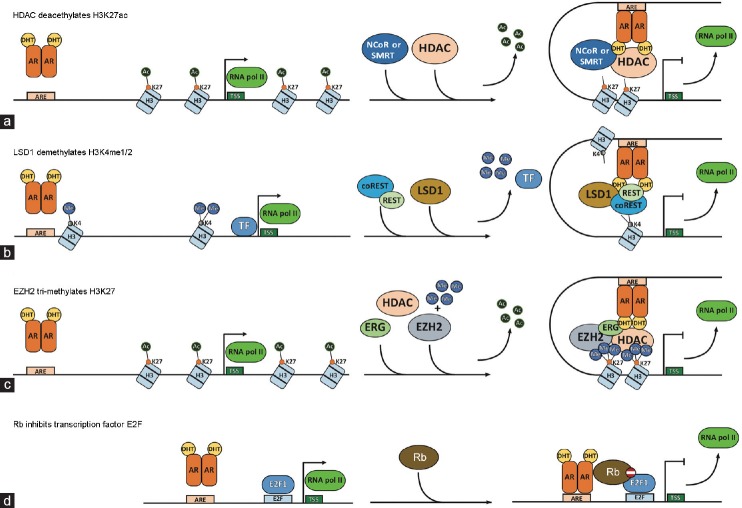Figure 1.
Mechanism of AR-regulated gene repression. Ligand (DHT)-bound AR dimerizes and translocates to the nucleus, where it binds to androgen response elements (ARE) at enhancers of target genes. (a) DHT-AR binding to ARE at target enhancers recruits repressive complex that consists of NCoR/SMRT and HDAC. DNA looping brings AR-repressive complex to proximity with target gene promoter, where HDAC deacetylates H3K27ac, causing chromatin inaccessibility and transcription repression. (b) Gene enhancers are enriched for H3K4me1/2 and gene promoters are enriched for H3K4me3. DHT-AR binding to ARE at target enhancers recruits REST/coREST and LSD1 complex, which demethylates H3K4me1/2 leading to enhancer deactivation. DNA looping further exposes target promoters to LSD1, which catabolizes H3K4me3 demethylation and promoter inactivation. (c) DHT-AR accumulation at target regulatory elements recruits ERG, EZH2, and HDAC repressive complex. HDAC removes acyl groups from H3K27ac, priming it for subsequent trimethylation by EZH2, resulting in epigenetic silencing. (d) AR mediates gene repression through direct binding to Rb. Thus, AR stabilizes Rb interaction with nearby E2F1 transcription activator, inhibiting its transcriptional activity. AR may also itself interact with E2F1 to remove it from chromatin, enabling the recruitment of E2F4 transcriptional repressor. AR: androgen receptor; NCoR: nuclear receptor corepressor; SMRT: silencing mediator of retinoid and thyroid receptors; REST: repressive element 1 silencing transaction. HDAC: histone deacetylase; LSD1: lysine-specific demethylase 1; ERG: ETS-related gene; EZH2: enhancer of zeste homolog 2.

